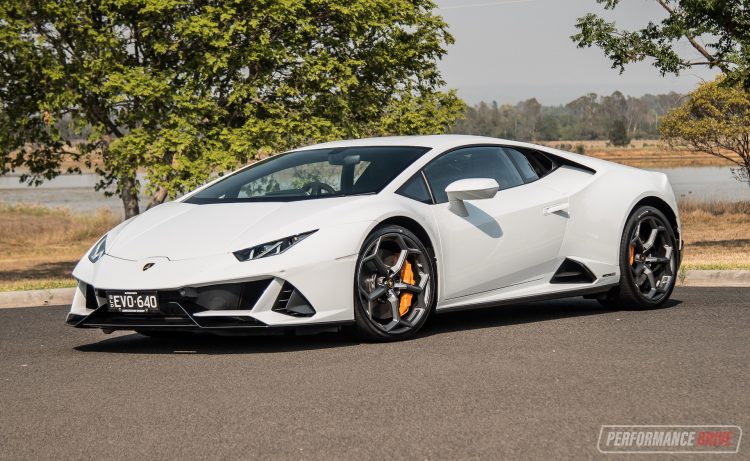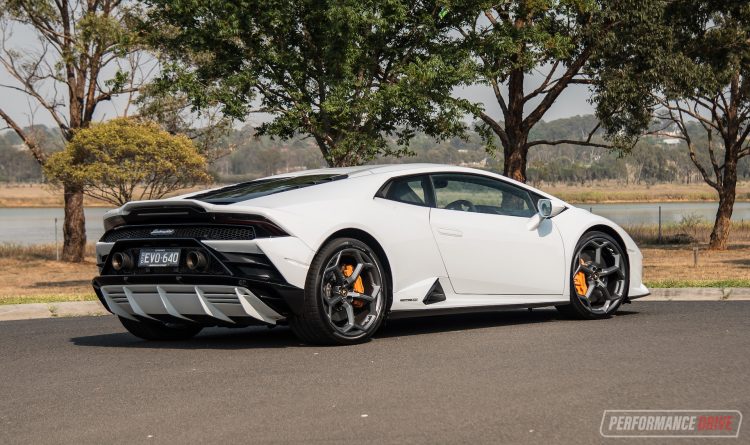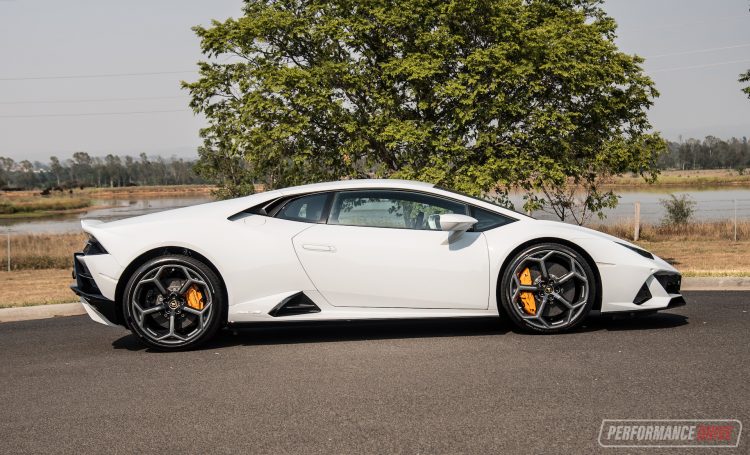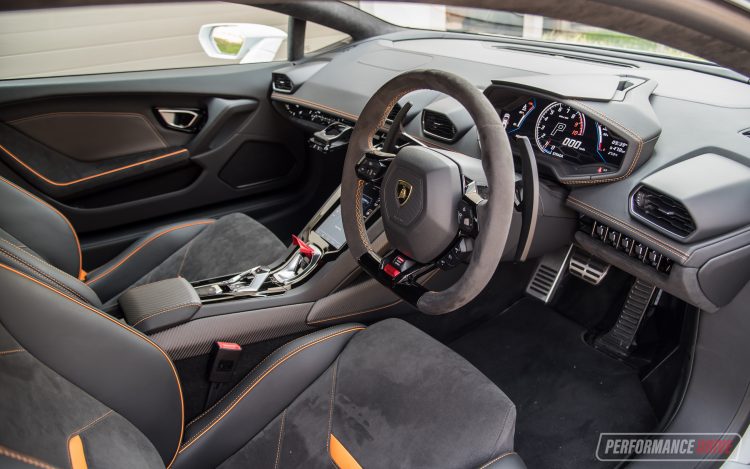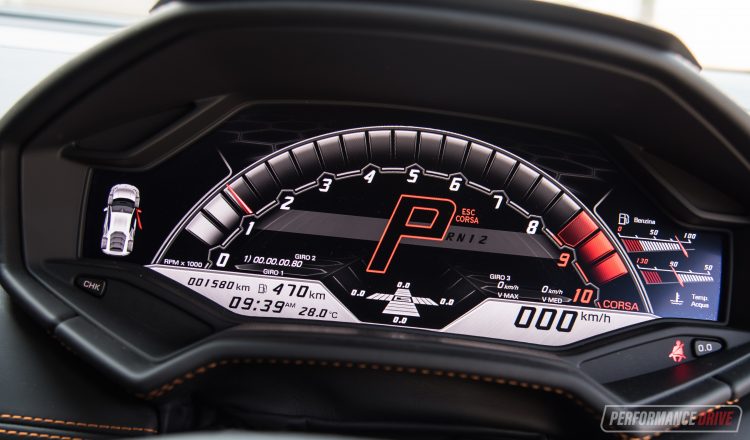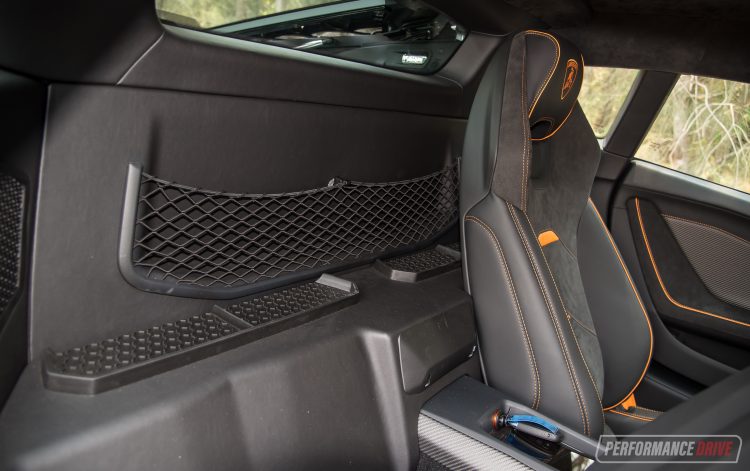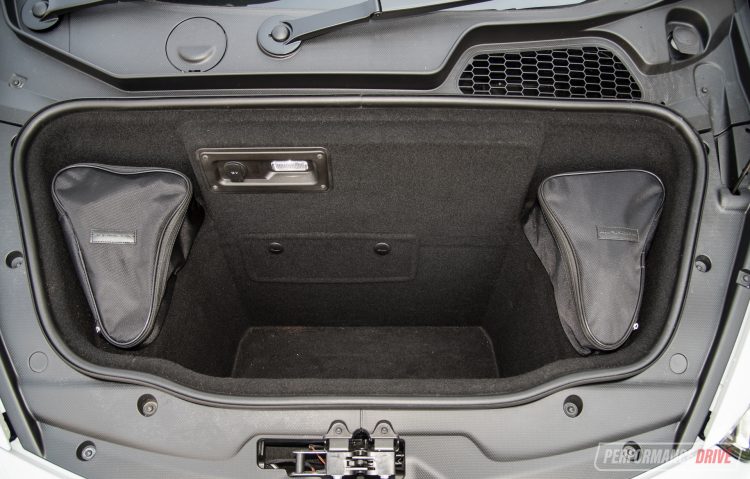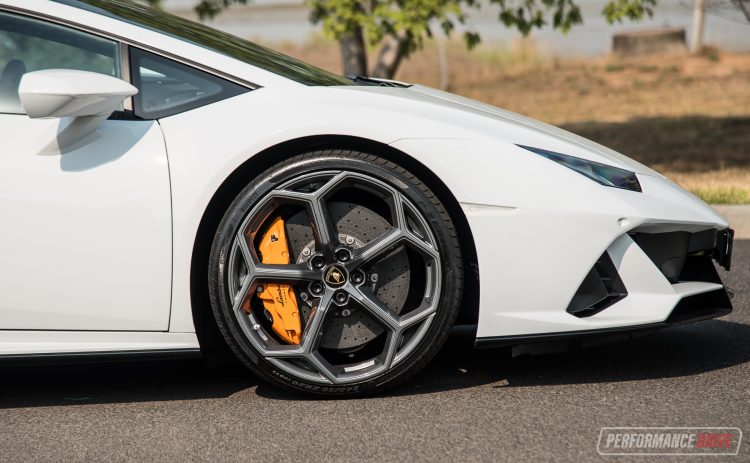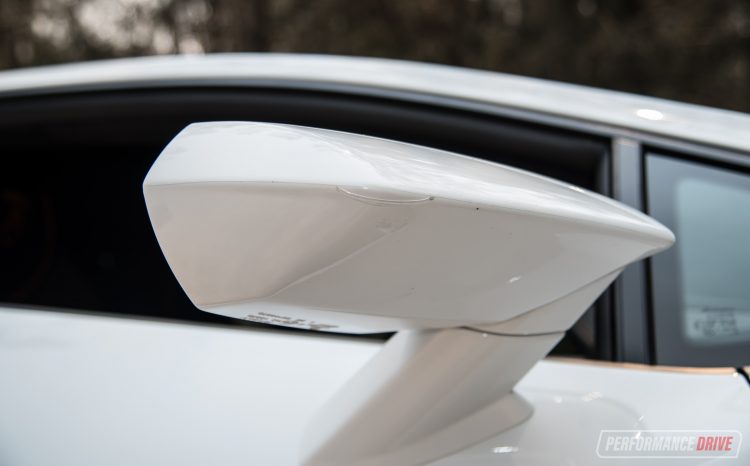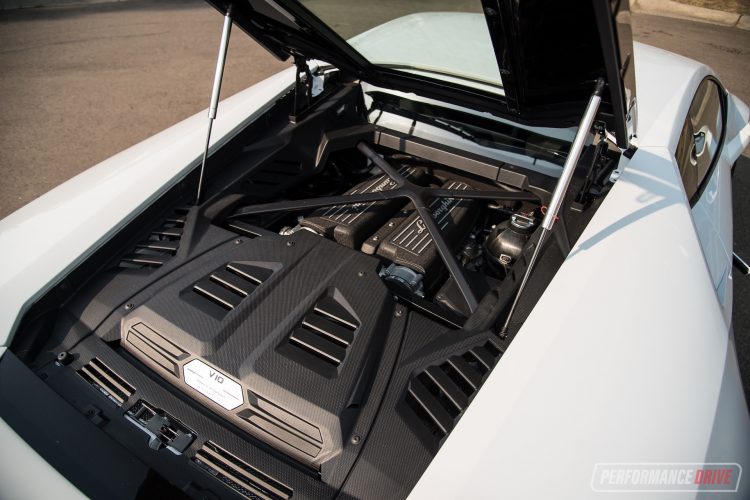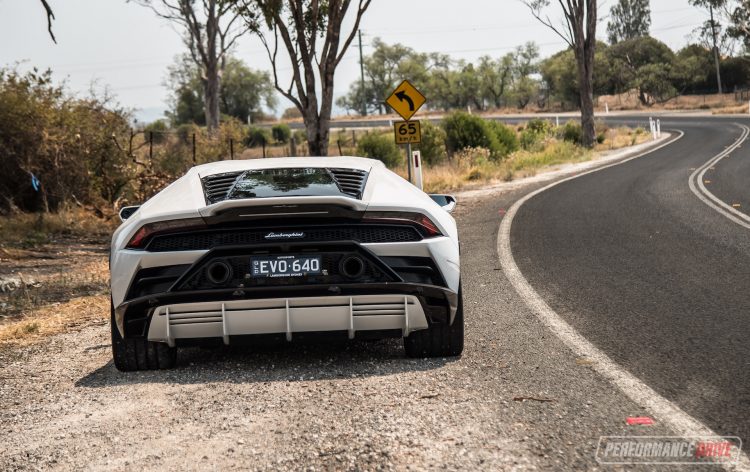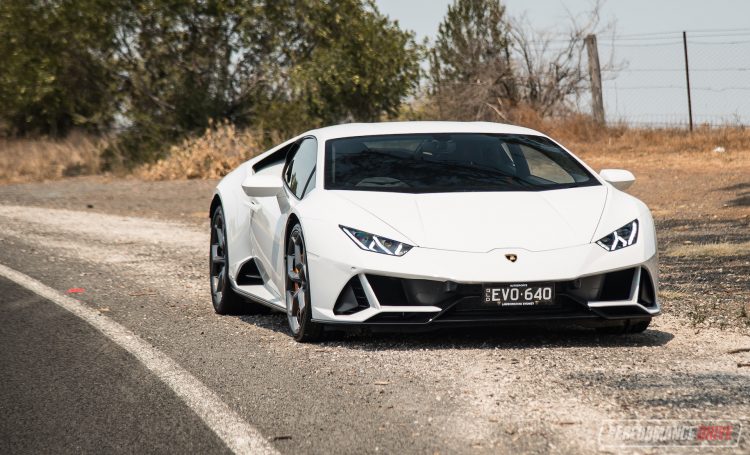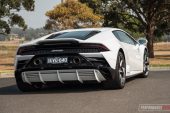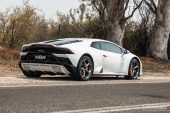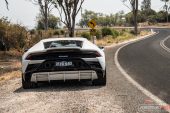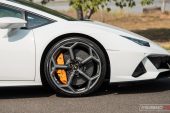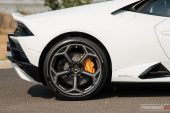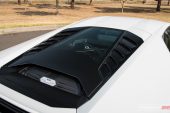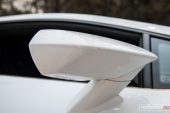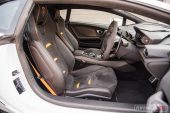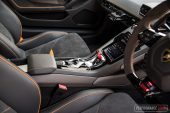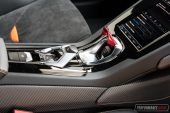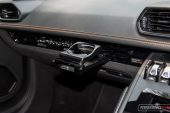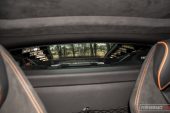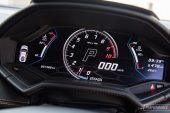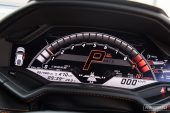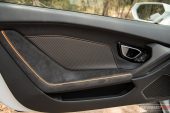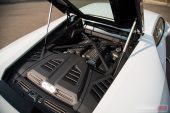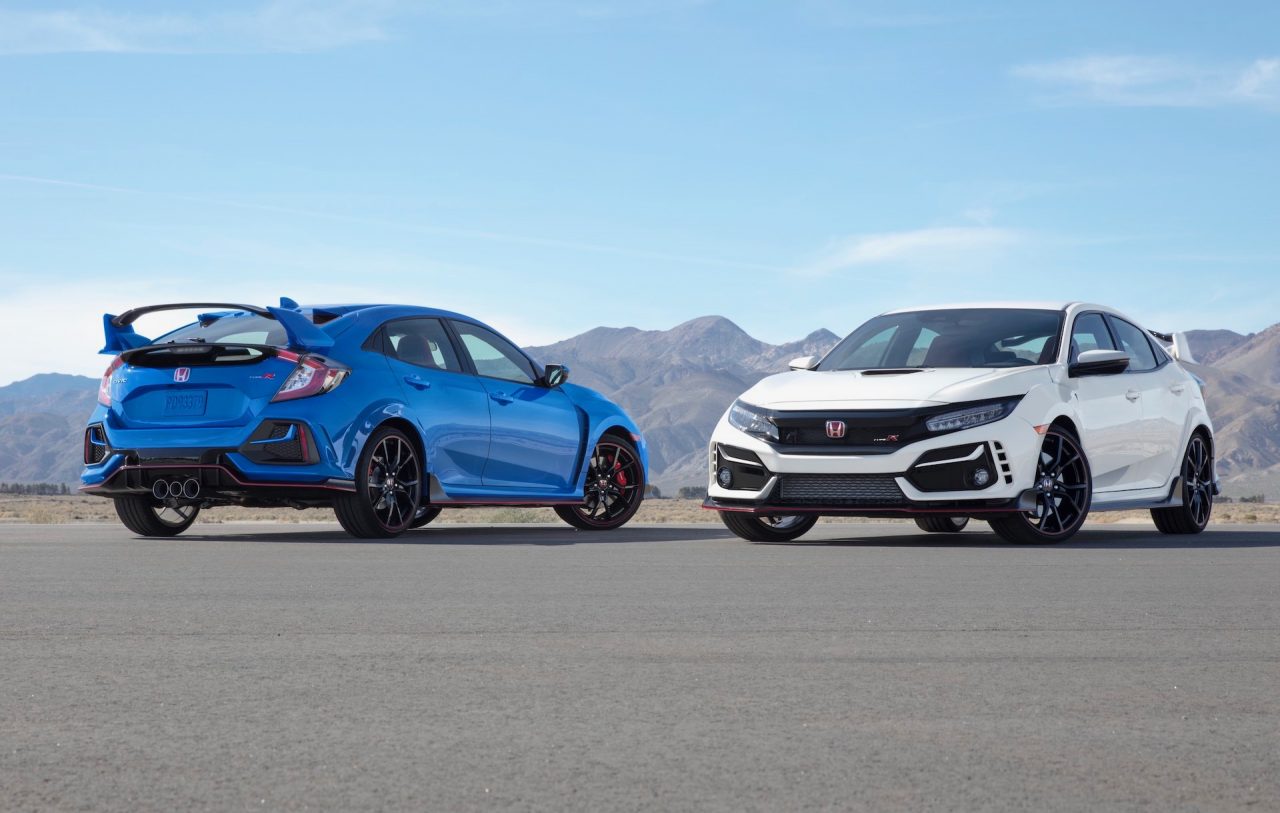This, the gorgeous new Lamborghini Huracan EVO, is pitched as a compilation of the best bits of all Huracan models since the nameplate’s initial debut back in 2014. Think of it as like a greatest hits version. And like a good greatest hits album, you just want to crank up the volume and enjoy every single track. Or, in this case, every gear. Time and time again.
If you want to buy a new Huracan in Australia right now you only have the EVO to choose from (according to the official Lamborghini website). You can get it in coupe AWD form (as tested), or open-top Spyder guise, or RWD coupe as revealed last week. There is no more LP610-4 or LP580-2 or anything like that, or even the track-focused Performante for that matter. But this is a good thing as the EVO is, as mentioned, the best of them all.
Power comes from the same shrilling 5.2-litre naturally aspirated V10 engine as all Huracans. You won’t find any turbochargers or superchargers, because, as any Italian will tell you, the finest things in life are done the traditional way. That’s not to say it’s an old dog of an engine on its last legs. Far from it, actually. In the EVO the V10 produces 470kW and 600Nm, which is the most powerful iteration yet and exactly the same as the hardcore Performante model – we told you it had the best bits, didn’t we?
Prices start from $459,441 for the AWD coupe, or from $384,187 for the RWD coupe (excluding on-roads). It’s not the most expensive supercar on the market but it is up there. For this sort of money you can get a 492kW Ferrari 488 GTB (from $469,988), or almost a 530kW McLaren 720S ($499,000).
2020 Lamborghini Huracan EVO – THE SPECS
[column width=”47%” padding=”6%”]Engine: 5.2-litre V10
Output: 470kW@8000rpm / 600Nm@6500rpm
Transmission: Seven-speed dual-clutch auto
Drive type: All-wheel drive
Wheels: F: 20×8.5, 245/30 R: 20×11, 305/30
ANCAP: Not tested
Tare weight: 1452kg
Power-to-weight: 3.08:1 (kg:kW)
Official fuel economy: 13.9L/100km
Economy during test: 15L/100km
Fuel capacity/Type: 80L/98 RON[/column] [column width=”47%” padding=”0″]Power efficiency: 33.81kW:L/100km
0-60km/h: 1.77 seconds*
0-100km/h: 3.13 seconds*
0-200km/h: 9.74 seconds*
60-110km/h: 1.79 seconds*
1/4 mile: 10.92 seconds at 212.0km/h*
Max acceleration: 1.137g
100-0km/h braking: 2.63 seconds at 33.01 metres*
Max deceleration: -1.240g
Decibel at idle (Corsa mode): 57/67*
Peak decibel at 60-100km/h: 102*
Priced from: $459,441[/column][end_columns]
* Figures as tested by PerformanceDrive on the day. Factory claims may be different
2020 Lamborghini Huracan EVO – THE PACKAGE
Buyers have a huge range of options to select from and bespoke personalisation avenues to go down. Let’s start by going over the exact specification of this test car, because, after all, Lamborghini will want to inspire us all and showcase some of the possibilities.
You and I might call it white but Lamborghini likes to be more extravagant than that, with pretty much everything. So, the paint colour you see here is Bianco Icarus, and it’s teamed with the high gloss black “Style Package”, with a body-coloured rear diffuser. Normally we’d suggest a Lamborghini has to be coated in a crazy colour, like bright yellow or fluoro green. But in white, sorry, Bianco Icarus, the Huracan looks absolutely breathtaking.
There’s a set of 20-inch Aesir alloy wheels in Graphite Grey, which provide a seductive contrast against that white body. Behind the staggered wheel sizes, which measure 8.5 inches wide (245/30 tyres) on the front and 11 inches wide on the back (305/30), is the carbon ceramic brake option with orange calipers ($2400). Again, orange might seem an unusual choice for the calipers but we think it works perfectly on this occasion.
Inside, the interior presents both drama and theatrics but it’s also surprisingly reserved and almost subtle in some areas. What you’re looking at is the Sportivo Alcantara upholstery package, with orange highlights. Actually, it’s not orange. It’s Arancio Leonis, which is Latin for ‘orange of the lion’. You might also notice the swathes of “carbon skin” trim for the door cards, centre armrest and knee pads. It’s very special.
This is exactly the colour combination we’d go for if we were buying a Huracan. The white exterior is somewhat subtle, for a supercar, yet it presents a very pure and almost crystal-like demeanour. And then the interior is warm and comforting, except the orange, sorry, Arancio Leonis stitching and highlights gives it a distinct edgy and fiery undertone.
Aside from the fun and excitement of decorating the cabin in whatever combination suits you, the Huracan EVO is now more practical and user-friendly than ever before. The main change in this department is the introduction of an 8.4-inch touch-screen interface. This replaces the very confusing and muddled functionality of the previous setup, which implemented the driver’s instrument cluster to display almost all functions.
The screen’s menu layout is a bit unconventional and does take a little while to get used to, with more screen presses than we’d like just to go to and from different menus. But the graphics and colour palette is totally Lamborghini. Hexagonal shapes are used for the in-screen buttons, following Lambo’s current design philosophy, while the screen itself with its capacitive sensitivity is beautifully precise and responsive. It can also be had with Apple CarPlay and Android Auto for complete connectivity.
In front of the driver is an almost-hexagonal instrument cluster that’s fully digital. Being digital means it can display a wide range of information, and switch between display modes. As such, the EVO’s screen presents three main layouts, each toggled via the “ANIMA” drive mode selector on the steering wheel, with Strada, Sport, Corsa, and a new configurable Ego mode. For example, in Strada (street) mode the display shows you some of the trip information as well as some of the common engine status such as temperature and so on. Some of this supplementary info can also be alternated.
Flick it into Sport mode and the entire screen transforms into a different layout, honing in on the more vital driving information. Further than that, Corsa (track) mode transforms again, leaving a large tacho, gear selection, and real-time g-force gauge in the prime view. This is all very handy and it does help to improve the overall practicality and versatility of the Huracan.
In terms of the comfort and space, the Huracan isn’t too bad for a supercar. The seat cushioning is soft enough for decent-length journeys, and they aren’t so rigidly bucketed that they poke you in the ribs. The driving position is highly adjustable too, so it’s easy to settle in and find your ideal setting. Visibility out the front is great thanks to the low windscreen, and out the back it is surprisingly good despite there being an engine to look over. Part of this is thanks to the glass engine cover, which is a $10,810 option.
This vehicle also has the “travel package” and cup holder. This brings in some useable storage netting along the bulkhead behind the seats, and the cup holder pops out from the dash, almost secretively – we guess, you can’t have a ghastly cup holder ruining this exquisite cabin design. There is also a very shallow centre console tub behind the arm rest. If you need to carry more gear there’s always the boot under the bonnet at the front, presenting 100L of volume and even a 12-volt socket.
2020 Lamborghini Huracan EVO – THE DRIVE
So, what’s it like to drive a modern Lamborghini? We’ll start with normal conditions and normal driving.
Firing up the V10 engine via the jet fighter ignition sequence immediately reminds you that this isn’t an ordinary car. Not that you’re likely to forget, at any point. The engine abruptly bursts into life with an almighty bark, especially when it’s cold. This is just before a whir and whine that kind of sounds like a 1980s F1 car starter. After that, it’s just a matter of selecting first gear via the paddle on the right and it engages D, with automatic shifting. Selecting M on the console switches to manual mode.
The EVO comes as standard with a hydraulic nose raise system providing extra clearance for the ultra-low front spoiler. This used to be an option on previous variants but it is absolutely necessary if you’re planning to use the car anywhere but a smooth road or track. The procedure to activate and deactivate the system is also easier than before, requiring a single tap of the dedicated steering column stalk. It operates pretty quickly too, physically raising the front end so you can slither over speed bumps and even conquer those gutterless curved driveways.
Driving in the default Strada mode is a breeze. There are no special skills or past experiences required to operate the steering or manage the sensitivity of the throttle. It won’t take off up the street at the merest of pedal movement, in other words. Even the ride is acceptable, thanks to the magneto-rheogical adaptive suspension. Well, it is firm, as you’d expect, but not bone-jarring. Sheer suspension travel is minimal and you will notice bigger bumps. But the smaller albeit jagged road imperfections, such as bridge connections, are soaked up with no major consequence.
Lastly, the engine and particularly the seven-speed dual-clutch transmission are rather tame and forgiving. In fact, this transmission behaves very well for such a high performance machine. Its calibration, in terms of the brains behind the shifting patterns, seems spot on for the Strada mode. It holds gears just long enough so you can enjoy a bit of that V10 excitement, yet it won’t upshift too early like some modern automatics in a hunt for pure economy.
Overall, this isn’t a tiring vehicle to drive in the mundane, daily situations. All of the controls are very conventional, to the point where your grandmother could probably drive this without much stress. That’s if she can bend down low enough to get in that is. As mentioned, even the visibility is good, reducing nervousness in tight and tricky conditions.
Our main complaint in terms of its practicality is that the nose is extremely low, but there is the nose-raise system, and this is a supercar after all. It’s also a shame that Lamborghini only offers a rear- and front-view camera and not a 360-degree camera system, as that would come in handy. A front and rear camera with parking sensors is a $5700 option as it is.
Another option that might be of interest is the transparent film/wrap for the bodywork. The purpose of it is to protect the paint but without taking anything away from the visual wow-factory of the Huracan’s design. It’s featured on this test car and while it is a good idea, it will set you back $6010.
On this vehicle the quality of the wrap was questionable in some places, with bubbling on the side mirror (pictured above). No doubt an easy fix, but still, when you’re paying this much for it you’d want it to be faultless.
When the time is right and you’re ready to finally head out onto a spirited road or track, engage the Corsa mode and be prepared to be astounded. This engine has to be one of our all-time favourite engines. It instantly sends goosebumps rippling down your spine and across your arms and thighs. It’s amazing that a piece of machinery can be so animalistic and provoke such intense visceral reactions.
And then there’s the speed and power it can provide. With 470kW produced at an ear-pinching 8000rpm, there aren’t many vehicles on the market at the moment that are as thrilling as this. With each full-throttle upshift, signified by an awe-inspiring pop from the exhaust, there is an immense wave of thrust that hurtles you forward, further and faster. If you ever get a chance to drive one or even take a passenger ride in one, it will change your whole perception of what you might think is the pinnacle of automotive performance. Especially for a road car.
For many buyers out there, this straight line stuff is probably going to be enough and you’ll be totally satisfied with your purchase. You’ll likely feel you got more than what you paid for. However, that’s only half the story. The other half is the car’s corner-carving competence.
Thanks to a new Lamborghini Integrated Vehicle Dynamics system, which constantly communicates with on-board accelerometers and gyroscopes, and monitors and reacts to the driver’s mood and mannerisms, the Huracan’s handling prowess is more comprehensive than ever before. This is all managed by a new Lamborghini Piattaforma Inerziale 2.0 (Lamborghini Inertial Platform) backbone that works as the car’s nervous system, connecting all major control areas together. There’s also rear-wheel steering for the first time, and torque vectoring.
It might sound like a bunch of technical jargon but what it means is the cornering capability is just as impressive as the speed and power. According to Redbook data, the EVO weighs only 5kg more than the hardcore, track-ready Performante model. Coming in at 1452kg (tare), the EVO is so light for a modern vehicle. It actually feels even lighter than that, especially when you’re pushing hard through corners and switching harshly between left and right.
Tip it in at speed and the nose darts exactly where you wanted it, and then you can almost immediately get on the power and the on-board brains will automatically sort out the torque distribution between the front and rear wheels for the most natural and enjoyable getaway. In Corsa mode the stability control is slackened off a bit so you can play around, and even slide the back end for little moments of joy.
Previously, the Huracan, in AWD form, always felt like it was set up for stability first and foremost. Safe and surefooted, yes, but sometimes leading to soft understeer at the very limit. Now, the EVO is flexible and malleable so you can adjust such characteristics in or out, yet thanks to the massive advances in technology the car is also safer and more predictable.
With the carbon ceramic brakes, the stopping performance is of course well-matched to the speed and power. We clocked a best 100-0km/h stop in just 33 metres. This is repeatable as well as we did back-to-back stops just to be sure, proving excellent resistance to fade and pedal feel. The only thing we don’t like about the brakes is the unusually high pedal. There’s a footrest to the left of the brake pedal which drops deep in the footwell, but then the brake pedal sits right up high.
2020 Lamborghini Huracan EVO – THE VIDEO
2020 Lamborghini Huracan EVO – THE VERDICT
What we love most about the new EVO (among many things) is the powertrain; it’s mechanical and raw and produces the best soundtrack you’ll hear from a modern car. There’s no fake exhaust sound or forced induction. This is all natural and pure. And that’s the overall feeling you get from the whole car.
Yes, you can find other cars on the market at the moment that are slightly quicker – even a Tesla Model S P100D is pretty close. But none, nothing that we can think of comes close to the overall excitement and passion of this. After each spirited drive you end up walking away talking about it or reliving the experience in your head again and again, for days afterward. And we think that’s what a supercar is all about. That’s what you’re paying for; the ability to create inspiring moments.
[column width=”47%” padding=”6%”]PROS:
– Such a masterpiece of an engine; sound, power, response
– Awesome handling and AWD programming; competent yet malleable
– Stunning to behold
– Flawless dual-clutch auto
– New touch-screen drastically improves functionality (compared with old layout)
[/column] [column width=”47%” padding=”0″]CONS:
– Some very pricey yet conventional options
– Not the best quality transparent wrap (a $6010 option)[/column][end_columns]
As always, if you’re thinking about buying a new car don’t forget to click here to speak with our car buying specialists.
